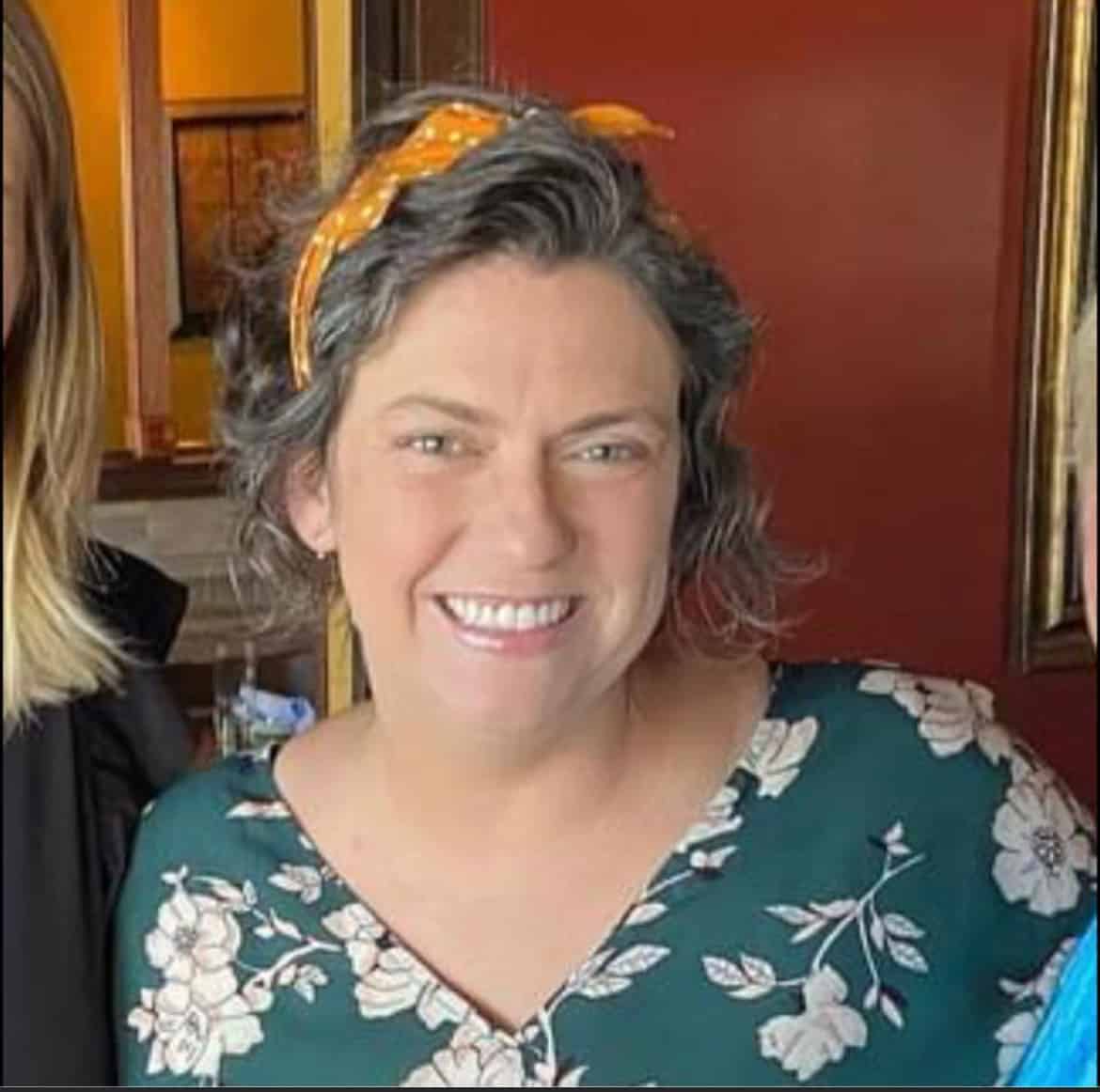I lived in a suburb of Seoul as an English teacher for a year and have been back to visit a handful of times. South Korea is one of my favorite places to visit (and honestly, to live!), and I'm excited you're considering going.
When I lived there, I had many family and friends come to visit, and these are the main sites and attractions I made sure to bring them to get a good feel for the history, food, and culture of Seoul.

With its impressive skyline, top-notch museums, palaces, and beautiful parks, this city has a vast spectrum of experiences for travelers of all ages.
Here are the best places I suggest you visit in Seoul as a first-time tourist:
Traditional and Famous Attractions
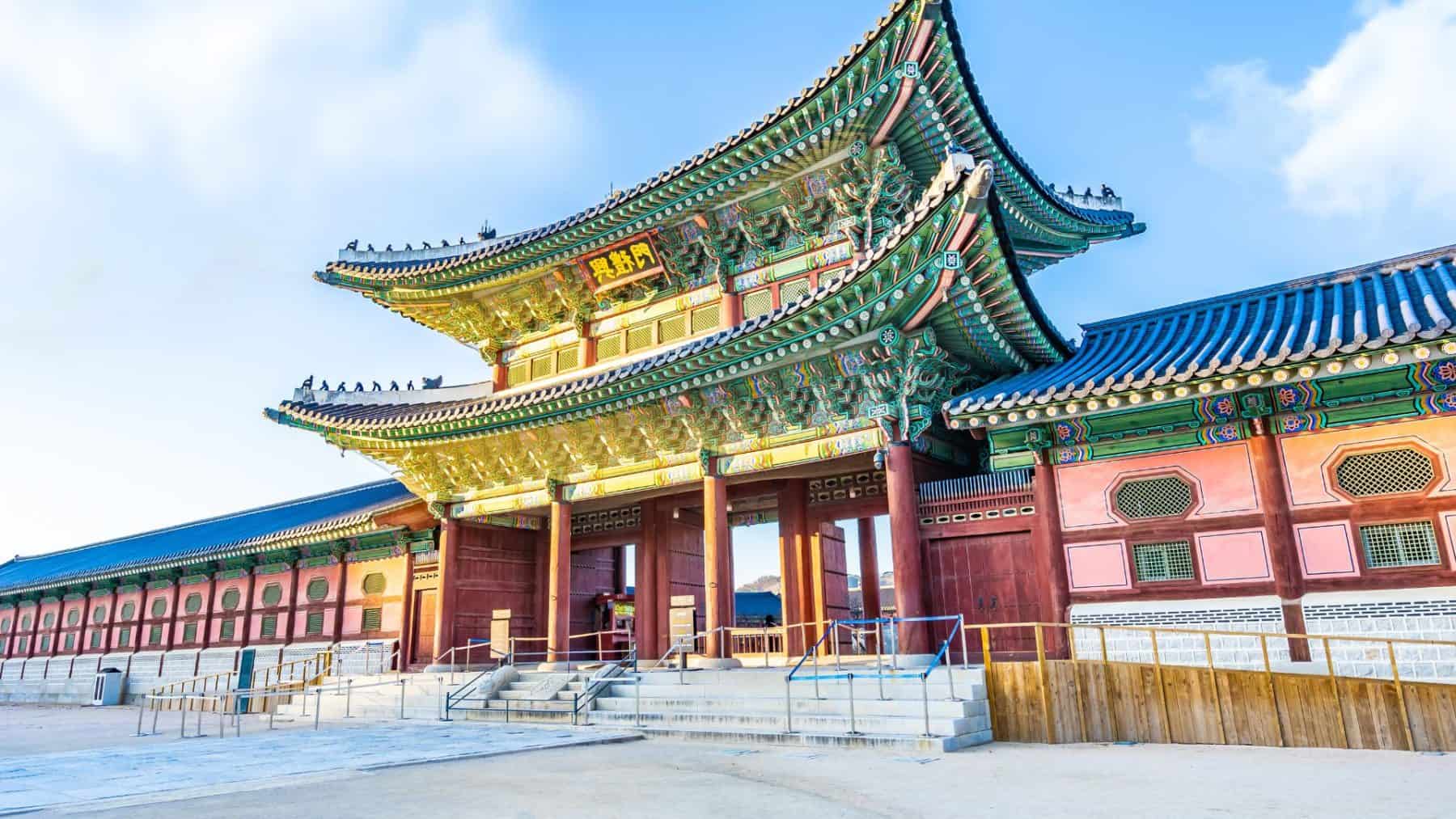
Gyeongbokgung Palace
This palace's architectural splendor, rich history, and cultural significance attract tourists worldwide. Gyeongbokgung Palace is one of the must-visit sites in Seoul and the country's most iconic royal palace.
Here, you'll enjoy the Changing of the Guard ceremony, learn about Korean heritage and culture, explore the palace's courtyards, and discover its stories.
The Changing of the Guard ceremony happens daily at 10 am and 2 pm (except Tuesdays, when the palace is closed)
Tours are available in English three times a day. They last about 1-1.5 hours to explore the main sites of the Palace grounds.
HOURS: The palace is open daily except Tuesdays:
January-February, November-December 09:00-17:00 (Last admission 16:00)
March-May, September-October 10:00-18:00 (Last admission 17:00)
June-August 09:00-18:30 (Last admission 17:30)
LOCATION: 161, Sajik-ro, Jongno-gu, Seoul
COST: The palace is free to visit for anyone under 18 or over 65. For those 19-64, it is only a few thousand won (that isn't as much as it seems; it's around $2! If you're curious about the currency in Seoul, read our post about South Korean currency)
TIP: For 10,000W (about $7 USD), you can get a ticket book that allows entrance to Gyeongbokgung Palace, Changdeokgung Palace - the Secret Garden included, Changgyeonggung Palace, Deoksugung Palace and Jongmyo Shrine. You have three months to visit all of these locations with this ticket book!
Bukchon Hanok Village
Near Gyeongbokgung Palace is a residential area of traditional architecture. This ancient village is an idyllic spot in Seoul that takes you back in time with its traditional houses and alleyways.
You'll find over 900 Hanok houses from the Joseon Era that have been magnificently preserved. It's an excellent spot to experience Korean culture and architecture. Plus, the village's views are outstanding, allowing you to capture impressive photos of the mountains and Seoul landmarks.
Keep in mind that this is a tourist attraction but also a residential area!
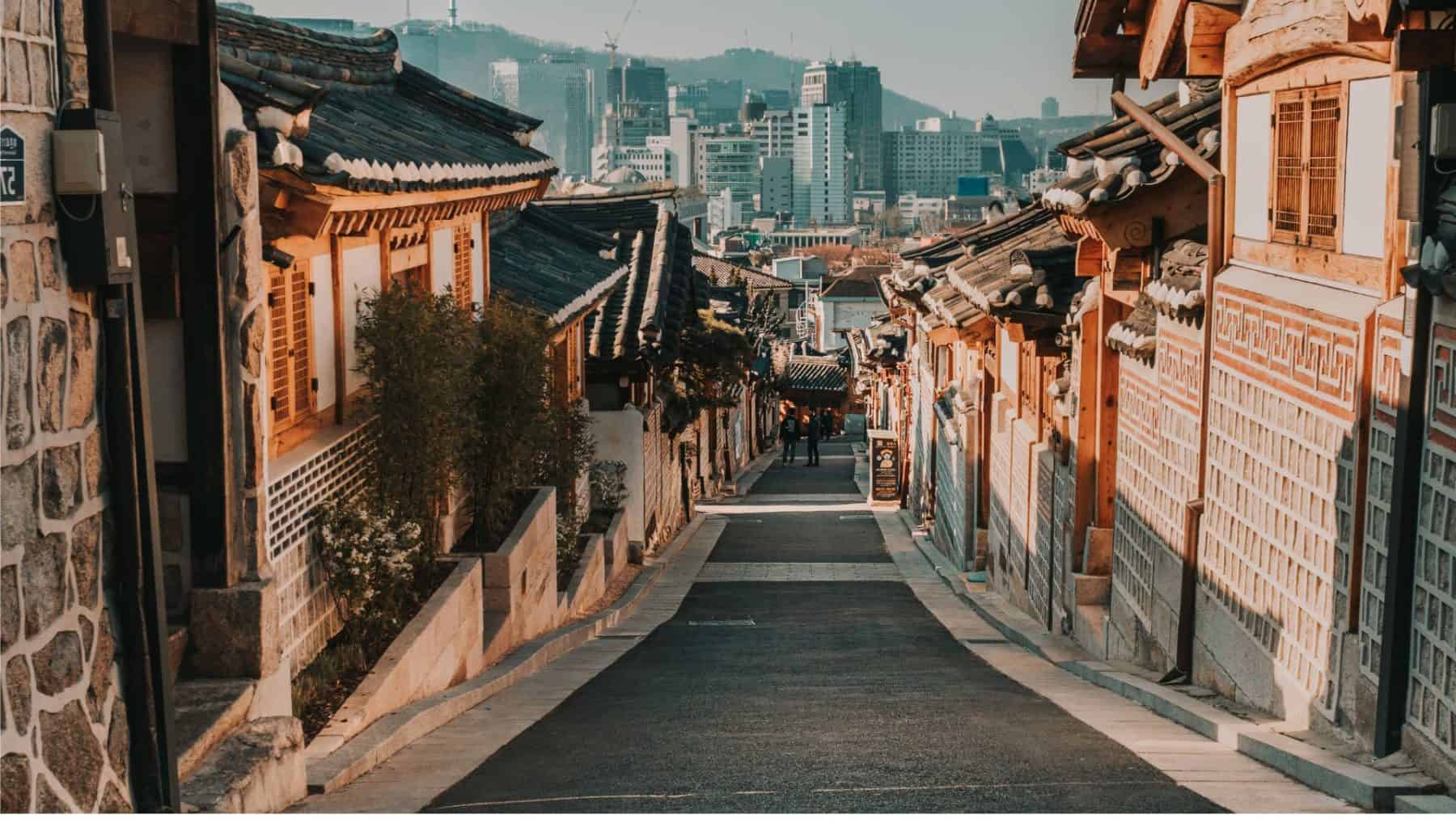
There is a self-guided tour of the Hanok Village that I like to follow that brings you to the best views and explains more about what you see in the neighborhood.
Namsangol Hanok Village: This open-air museum is an excellent place to learn about traditional Korean culture. The museum comprises of five traditional Korean houses built in the style of the Joseon Dynasty. Visitors can explore the grounds and admire the artistry involved in the house's construction.
HOURS: Weekdays & Saturdays 10:00-17:00. The main street is closed on Sundays!
LOCATION: 37, Gyedong-gil, Jongno-gu, Seoul
COST: Free!
Namsan Seoul Tower
Namsan Tower offers breathtaking views of Seoul's skyline; on a clear day, you can see as far as the Yellow Sea.
Also known as the Seoul Tower, Namsan Tower stands at the top of Mount Namsan and is the second-highest observation tower in Asia. You can get to the tower through a cable car ride or hiking to the top.
Once there, you can enjoy the restaurant, love locks, and the famous "Seoul" sign.
HOURS: Weekdays 1030 am - 10 30 pm | Weekends/Holidays 10 am - 11 pm
LOCATION: The tower is in the Namsan Mountain Park area which is closed to cars. You can get to the tower by shuttle bus, city tour bus, or walking from a nearby parking lot. However, my favorite way is to take the cable car from Myeong-dong subway station. It's 9,000 - 15,000W to ride the cable car.
COST: 16,000-21,000W
Changdeokgung Palace
Another stunning palace from the Joseon Dynasty, Changdeokgung Palace, is a UNESCO World Heritage site and a must-see attraction in Seoul. This is in the eastern part of Seoul, where Gyeongbokgung is in the west.
The palace grounds include a beautiful garden that changes with the seasons and several historic buildings that showcase traditional Korean architecture.
One of the highlights is the Huwon Secret Garden. The two-story library pavilion, Juhamnu Pavilion, is a must-see but I love the Changdeokgung Chinese juniper. This is a 750-year-old tree!
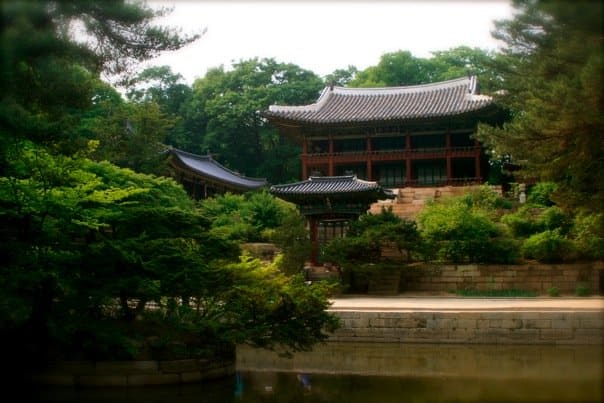
Visitors can take a guided tour of the palace and learn about the history of the Joseon Dynasty. English tours run twice a day (and separate tours of the gardens also run twice a day.)
HOURS: Daily, except Mondays.
April-October: 9:00-18:30
December-February: 9:00-17:00
November and March: 9:00-17:30
The secret garden has separate hours that depend on the season.
LOCATION: 99, Yulgok-ro, Jongno-gu, Seoul
COST:
Adults (19-64): 3,000 won
Children (7-18): 1,500 won
You can also enter for free if you're wearing a hanbok (traditional Korean outfit) or on the last Wednesday of every month.
TIP: For 10,000W (about $7 USD), you can get a ticket book that allows entrance to five historic attractions in Seoul.
Gyeongbokgung Palace, Changdeokgung Palace, the Secret Garden, Changgyeonggung Palace, Deoksugung Palace, and Jongmyo Shrine. You have three months to visit these locations with this ticket book!
Jogyesa Temple
Nestled in the heart of bustling Seoul, Jogyesa Temple is a must-visit destination for anyone seeking a peaceful and serene escape from the city’s hectic pace.
Home to the Jogye Order, one of Korea’s largest and most important Buddhist sects, this temple has been a spiritual oasis for locals and tourists for over six centuries.
Whether you’re interested in the temple’s religious significance or stunning architecture or simply seeking a moment of quiet reflection, Jogyesa Temple offers a magical experience that is not to be missed.
HOURS: The temple grounds are open 24 hours, but the Main Dharma Hall and Paradise Hall are closed at night (after 9pm).
LOCATION: 55, Ujeongguk-ro, Jongno-gu, Seoul
COST: Free!
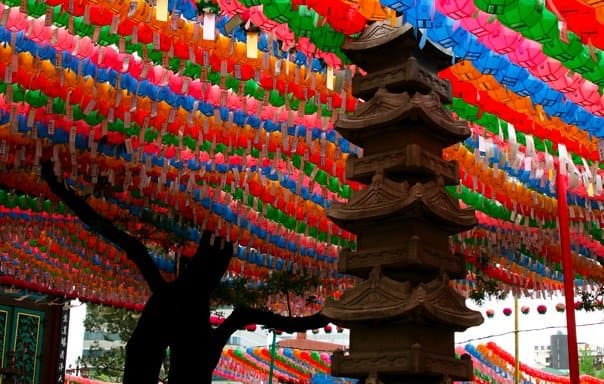
Lotte World
While I often write about traveling with kids now, I've never taken my kids here, but I have been many times myself!
It is a little cheesy in an endearing Korean way, but it is fun for any age.
Lotte World is one of Seoul's most popular theme parks and with good reason. It boasts the world's largest indoor theme park and an outdoor amusement park, so whatever the weather, you can still enjoy the rides. The indoor park has an impressive roller coaster, bumper cars, and a pirate ship ride, while the outdoor park features a carousel, a flume ride, and a giant Ferris wheel. Lotte World also has an ice rink and an aquarium, so there is something for everyone.
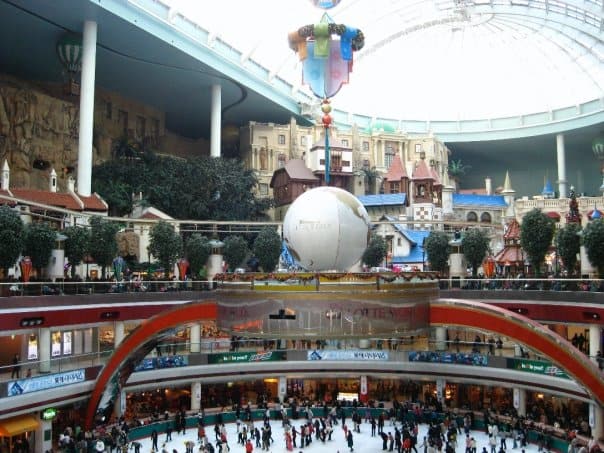
Korean Baseball Game
I love baseball games (Go Nats!) and the Korean baseball games are next-level fun. The best part is when the entire stadium joins in a chant!
The LG Twins and the Doosan Bears are the local teams in Seoul. They share the Jamsil Baseball Stadium and play every day but on Mondays from April to September.
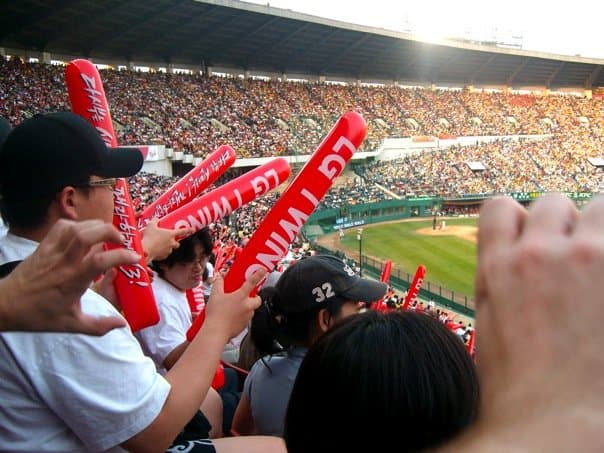
DMZ Day Trip
The Demilitarization Zone border between South and North Korea is a popular day trip from Seoul.
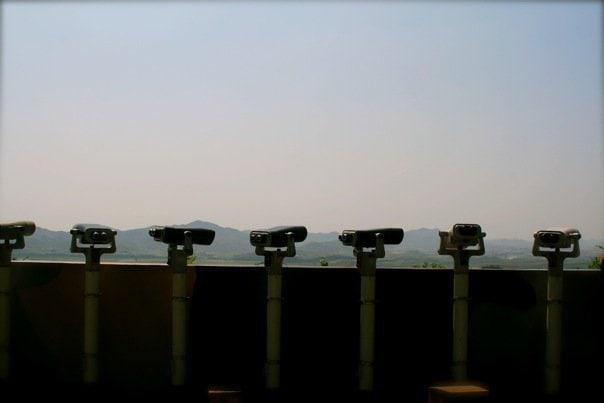
If you want to visit, you must be on a guided tour, and there are some options from Seoul. These are about 6-7 hours and include Imjingak Park, the Freedom Bridge, Dora Observatory, the Third Infiltration Tunnel, and the Exhibition Hall.
Viator has a few different DMZ Tour Options.
Most are 6-8 hours long including transportation to and from and cost around $48 per person.
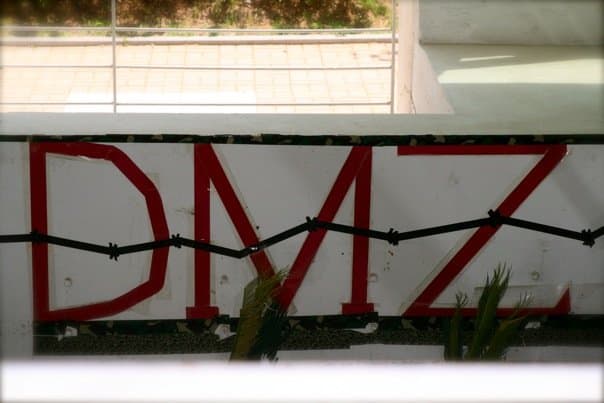
BEST PLACES TO EAT IN SEOUL:
Before discussing WHERE to eat in Seoul, here is a quick guide to some food you should try in South Korea.
Kimchi
Kimchi is Korea's national dish and can be found in every corner of Seoul. It is a spicy and savory side dish made of fermented vegetables, usually cabbage. It is often served alongside rice and other main dishes. The combination of hot, sour, and salty flavors makes it a favorite among locals and tourists. You can find it in almost every restaurant and even supermarket.
Personally, I don't like the standard kimchi but there is a white kimchi (it was always called bachelor's kimchi by the people I were with!) that is not spicy.
Bibimbap
Bibimbap is a signature Korean dish that consists of a bowl of rice topped with sautéed vegetables, gochujang (Korean chili paste), and meat. It is often served in a hot stone pot, which gives it a crispy texture. Mix the ingredients before eating or enjoy it layer by layer. There are many variations of bibimbap, including seafood and vegetarian options.

Jokbal
If you are looking for a unique culinary experience, jokbal is definitely worth a try. Jokbal is a Korean pork dish where the meat is simmered for hours until it is soft and tender. It is typically served with various condiments such as kimchi, garlic, and soy sauce. The texture is gelatinous, and the flavor is salty with a hint of sweetness.
Tteokbokki
Tteokbokki is a popular Korean street food that can be found in many markets in Seoul. It is made of soft and chewy rice cakes, which are stir-fried with gochujang, fish cakes, and vegetables. The spicy and sweet sauce is what makes this dish unique and flavorful. You can also opt for different variations of tteokbokki, such as adding cheese or instant noodles.
Korean Fried Chicken
Korean fried chicken (funnily enough also called KFC) is a beloved dish in Seoul, and it's easy to see why. You might be familiar with the style called bonchon. The chicken is usually double-fried, producing a crispy outer layer and juicy meat. It is often coated in spicy or sweet and sour sauce, adding to the flavor profile. You can find KFC restaurants all over the city, and there are numerous flavors.
Dak-kkochi
This was my favorite. I lovingly called it meat on a stick (though there are also green onions on it, too). It is my favorite street food. The barbeque-style skewered grilled chicken is often sold in late-night areas. It's the perfect post-Karakoe snack!
Historic and Famous Restaurants in Try in Seoul
A great way to try all of these food options is on a food tour.
One of the best food tours is the Seoul Alley's Food Tour. This is a 5-hour tour that focuses on drinks and food that you really won't find on your own. The small alleys and local shops have the best food but if you don't know Korean or you're way around the city, having a guide can really help.
The tour does not include the price of food or drink. This is our I prefer to both lead and take food tours. You split the cost and its all so cheap but you also have the flexibility to choose what you want.
NOTE: There are no non-meat options on this tour.
The tour runs every day but Sundays and Wednesdays and is $85 per person, which includes the tour and drinks. Food is on your own.
If you don't want a guided tour, now that you know some foods to try in South Korea, here are some places to eat.
Gwangjang Market
Gwangjang Market is a mecca for delish Korean street food if you're a foodie. Established in the early 1900s, this market claims to be the country's first-ever market.
You'll discover dumplings, pancakes, soups, noodles, and other Korean dishes. Try the classics, such as bibimbap and tteokbokki.
Poom Seoul
For more than 60 years, Poom Seoul has been a favorite among locals and tourists. This historic restaurant is in the heart of the city's shopping district and is known for its traditional Korean dishes, especially its signature dish, naengmyeon (cold buckwheat noodles).
The restaurant's interiors are adorned with traditional Korean decor, creating a charming and cozy atmosphere that makes dining here a truly unforgettable experience.
Tosokchon
If you're looking for traditional Korean cuisine, you can't go wrong with Tosokchon.
Located near Gyeongbokgung Palace, this restaurant has served ginseng chicken soup (samgyetang) for over 30 years. What sets Tosokchon apart is the high-quality ingredients used in its dishes, sourced from all over South Korea. The restaurant's interiors also reflect the traditional Korean style, with a beautiful garden and a peaceful atmosphere.
Wooraeok
Wooraeok is a restaurant that has been around for over 70 years and is famous for its Korean barbecue.
This is a great place to come with friends or family and enjoy a meal together, as the restaurant offers communal seating and a lively atmosphere. In addition to the barbecue, Wooraeok also serves traditional Korean dishes and a range of side dishes that complement each main dish perfectly.
Myeongdong Kyoja
Myeongdong Kyoja is one of the best noodle restaurants in Seoul, offering traditional Korean dishes such as kalguksu (knife-cut noodle soup) and bibimguksu (spicy mixed noodles). The restaurant has been in business for over 50 years and continues to attract visitors with its hearty and delicious food. The interiors are simple and unassuming, but the food speaks for itself.
Neighborhoods in Seoul to Explore
Hongdae
Hongdae is an excellent place to experience the city's nightlife and shopping scene. This vibrant neighborhood bustles around the Hongik University area with art, fashion, clubs, coffee shops, and street performances.
It attracts young and trendy locals with its excellent indie music scene, coffee houses, and boutiques.
Hongdae Mural Street near the Sangsu subway station is a great thing to do in the neighborhood for street art.

Myeong-dong Shopping District
Shopaholics will love exploring the bustling streets of Myeong-dong. This trendy district is known for its bright lights, street food, and numerous shops selling everything from high-end luxury brands to local Korean souvenirs. Sample Korean delicacies like tteokbokki, Korean fried chicken, and bingsu while browsing the shops. Plus, if you're lucky, you might spot a K-Pop celebrity or two.
This is a good place to go shopping for some of that famous Korean skincare. skinfood is one of my favorite and there is one located here.
Gangnam
Thanks to the K-pop hit "Gangnam Style", you may have heard of this neighborhood, but there's so much more to discover here! Gangnam is Seoul's business and entertainment hub, home to some of the city's best restaurants, shopping centers, and nightclubs.
To taste luxury, visit the iconic COEX Mall, which houses over 260 stores, a movie theater, an aquarium, and more. Or, if you prefer the great outdoors, take a stroll through nearby Bongeunsa Temple, a stunning Buddhist temple that dates back to the 10th century.
Our partner, Mark's Tours offers a Gangnam neighborhood tours.
Searching Availability...
Insadong
If you want to taste traditional Korean culture, look no further than Insadong! This neighborhood is a favorite among locals and tourists for its picturesque alleys, traditional tea houses, and artisanal shops selling Korean pottery, textiles, and souvenirs.
You'll also find several historic temples and palaces nearby, including Gyeongbokgung Palace, which served as the main royal palace during the Joseon dynasty.
A neat thing to see in Insadong is Starbucks. Now, this is not normally I place I recommend visiting (unless you have young kids like me who sometimes just want something familiar like a cake pop). Since Insadong is the traditional district, there is a law that all stores must have their sign in Hangul (the Korean language).
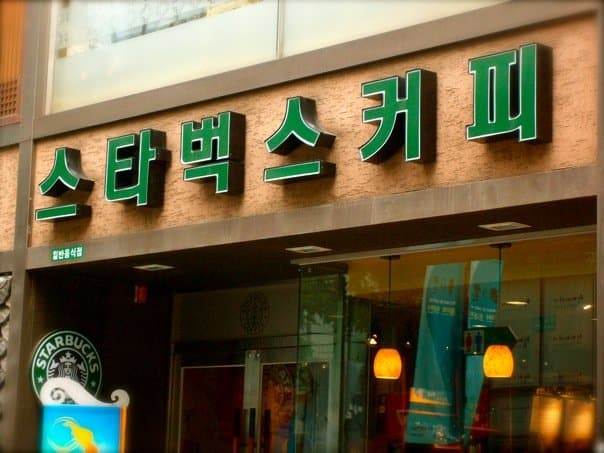
Itaewon
Known for its multicultural vibe, Itaewon is a great neighborhood to visit for international cuisine and nightlife. Here, you'll find restaurants serving everything from Indian curries to Thai noodles to American burgers and bars and clubs that stay open well into the night. Itaewon is also known for being LGBTQ-friendly, with several gay bars and clubs clustered around the main street.
As an American in South Korea, I came here frequently for a taste of home so if you're travelling instead of moving to South Korea, you probably don't need a reminder of home. I have a tradition of trying Chinese food in every country I go to - is oddly different everywhere you go - and there are some great options in this international neighborhood.
Many well known hotels are located in this neighborhood, too, so there is a good chance you end up staying here.
Museums I like to visit in Seoul:
National Museum of Korea
This is the largest museum in Korea, and it is a must-visit for anyone interested in Korean culture and history. The museum has a vast collection of over 220,000 artifacts, including national treasures like the Golden Crown of Silla, from as early as the prehistoric era. The museum is easy to navigate, and the exhibits are labeled in both Korean and English.
The museum is free and open daily with the exception of a few holidays.
10:00 am ~ 6:00 pm (it stays open late on Wednesdays and Saturdays)
Leeum Samsung Museum of Art
This museum is an excellent place to see contemporary and traditional Korean art. The collection comprises masterpieces from both Korean and international artists, including works by Warhol and Monet. It is a perfect destination for art lovers.
It is another free museum to visit. Open daily 10:30 am to 6:00 pm, but is closed on Mondays.
Korean War Memorial Museum
Another free museum, the Korean War Memorial Museum is a must-visit for anyone interested in the modern history of Korea. It houses a vast collection of artifacts related to the Korean War, including military hardware, equipment, and uniforms.
It is also closed on Mondays, but open every other day 9:30 am to 6:00 pm.
Seoul National Science Museum
The Seoul National Science Museum is an excellent place to take budding scientists. The museum is packed full of interactive exhibits on physics, biology, and chemistry. Highlights include the 4D theater, the earthquake simulator, and the planetarium. The museum suits all ages, but the younger ones will enjoy the exploration room and the dinosaur exhibit.
It is open daily except Mondays from 9:30 am to 5:30 pm.
There are different admission tickets for the different parts of the museum but they are all around 1,000-3000W.



